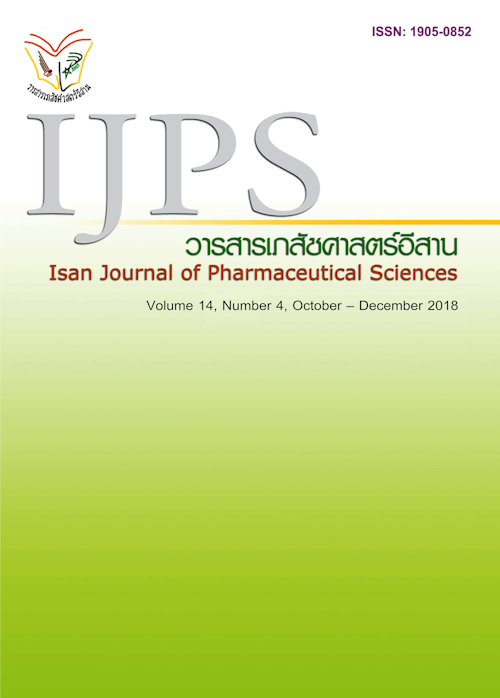Lipid Nanoparticles Containing Sesame Oil for Skin Occlusion
Main Article Content
Abstract
Introduction: Xerosis is a condition of skin with a significant change in the appearance and surface condition of the stratum corneum due to epidermal water loss. Sesame oil which contains lignin has been reported to have antioxidation and anti inflammation activities as well as to provide skin moisturizer for dry skin condition. The encapsulation of sesame oil in lipid nanoparticles is a safety delivery system which can deliver the active ingredient to the target organ and enhance the protection of water loss from skin. The objective of this research was to study the effect of lipid nanoparticle compositions on particle size and skin occlusion effect. Methods: Lipid nanoparticles were prepared by emulsion beaker method and the particle size was reduced by homogenizer and probe sonicator. The ratio of liquid lipid (sesame oil), amount of surfactant and total lipids in formulations were investigated. Particle size and polydispersity index (PDI) were measured by laser light scattering. In vitro occlusion factor was investigated and water was served as negative control. Results: Percentage of surfactant and total lipid in the formulation affected particle size and size distribution. As expected, increasing percentage of poloxamer 188 from 2.5 to 5.0, the obtained particle size was decreased. However, increasing the percentage of poloxamer content to 7.5% w/w resulted in larger particle size. The particle size increased when the total lipid was increased. Increasing ratio of sesame oil did not influence the particle size. The occlusion effect was enhanced when the amount of solid lipid was increased. Conclusion: Type and content of formulation composition affected the particle size and the ability to protect skin water loss.
Article Details
In the case that some parts are used by others The author must Confirm that obtaining permission to use some of the original authors. And must attach evidence That the permission has been included
References
Allen T. Photon correlation spectroscopy. in particle size measurment. Allen T. 426. Vol.1. London: Champman & Hall, 1997.
Dar AA, Verma NK, Arumugam N. An updated method for isolation, purification and characterization of clinically important antioxidant lignans– Sesamin and sesamolin, from sesame oil. Ind Crops Prod 2015;64: 201-208.
de Vringer T. Topical preparation containing a suspension of solid lipid particles. European Patent 91200664; 1992.
Finsey R. Particle sizing by quasi-elastic light scattering. Adv. Colloid Interface Sci 1994; 52: 79-143.
Jinarat D, Yingngam B, Rungseevijitprapa W. Development and characterization of Curcuma comosa extract loaded nanostructured lipid carriers. IJPS 2017; 13 Suppl: 163-173.
Kumar MC, Sathisha UV, Dhaemesh S, Appu Rao AG, Singh SA. Interaction of sesamol (3,4-methylenedioxyphenol) with tyrosinase and its effect on melanin synthesis. Biochimie 2011; 93: 562-569.
Lemuel M, Tianying L. Absolute viscosities of vegetable oils at different temperatures and shear rate range of 64.5 to 4835 s-1. J.Food Process 2014; 1-6.
Rungkadilok N, Pholphana N, Mahidol C, et al. Variation of sesamin, sesamolin and tocopherols in sesame (Sesamum indicum L.) seeds and oil products in Thaiand. Food Chem 2010; 122(3): 724-730.
Rungseevijitprapa W. Solid lipid nanoparticles (SLN) for drug and cosmetic delivery. Ubonratchathani: Ubonratchathani university press; 2011.
Shenoy RR, Sudheendra AT, Nayak PG, Paul P, Kutty NG, Rao CM. Normal and delayed wound healing is improved by sesamol, an active constituent of Sesamum indicum (L.) in albino rats. J Ethnopharmacol 2011; 133(2): 608-612.
Souto EB, Wissing SA, Barbosa CM, Muller RH. Evaluation of physical stability of SLN and NLC before and after incorporation into hydrogel formulations. Euro. J.Phar.Biophar 2004; 58: 83-90.
Srisayam M, Weerapreedakul N, Sribuarin P. In vitro antioxidant activity of white, black and red sesame seeds. IJPS 2014; 10(2): 136-146.
Suksiriworapong J, Rungvimolsin T, A-gomol A. Development and characterization of lyophillized diazepam-loaded polymeric micelles. AAPS Pharm Sci Tech. 2014; 15(1): 52-64.
Teeranachaideekul V, Boonme P, Souto EB, Müller RH, et al. Influence of oil content on physicochemical properties and skin distribution of Nile red-loaded NLC. J Control Release 2008; 128(2): 134-141.
Uehara J, Shindo S, Numazawa S, Yoshida T. Inhibitory effect of sesamol on LPS-mediated inflammatory response. Toxicol Lett 2010; 196 Suppl: S241.
Uner M. Preparation, characterization and physico-chemical properties of solid lipid nanoparticles (SLN) and nanostructures lipid carriers (NLC): their benefits as colloidal drug carrier system. Phamazie. 2006; 61(5): 375-386.
Washington C. Photon correlation spectroscopy, in particle size analysis in pharmaceutics and other industries. 135. Newyork: Ellis Horwood; 1992.
Wissing S, Müller RH. The influence of the crystallinity of lipid nanoparticles on their occlusive properties. Int J Pharm 2002; 242(1-2): 377–379.
Wissing SA, Müller RH. Cosmetic applications for solid lipid nanoparticles (SLN). Int J Pharm 2003; 254: 65-68.
Xu J, Chen S, Hu Q. Antioxidant activity of brown pigment and extracts from black sesame seed (Sesamum indicum L.). Food Chem 2005; 91(1): 79-83.
Yadav NV, Sadashivaiah, Ramaiyan B, Acharya P, Belur L, Talahalli RR. Sesame Oil and Rice Bran Oil Ameliorates Adjuvant-Induced Arthritis in Rats: Distinguishing the Role of Minor Components and Fatty Acids. Lipid. 2016; 51(12): 1385-1395.
Yang Y, Corona A, 3rd, Schubert B, Reeder R, Henson MA. The effect of oil type on the aggregation stability of nanostructured lipid carriers. J Colloid Interface Sci 2014; 418: 261-72.
Yingnngam B, Phimpanit Y, Wongkasemchai, Sila-on W et al. Encapsulation of rice bran oil in solid lipid nanoparticles (SLN) for skin hydration and viscoelasticity. IJPS 2007; 3(2): 8-22.
Yuan H, Wang LL, Du YZ, You J, Hu FQ, Zeng S. Preparation and characteristics of nanostructured lipid carriers for control-releasing progesterone by melt-emulsification. Colloids Surf B Biointerfaces 2007; 60(2):174-9.
Zirak MB, Pezeshki A. Effect of Surfactant Concentration on the Particle Size, Stability and Potential Zeta of Beta carotene Nano Lipid Carrier. IJCMAS 2015; 4(9): 924-32.


